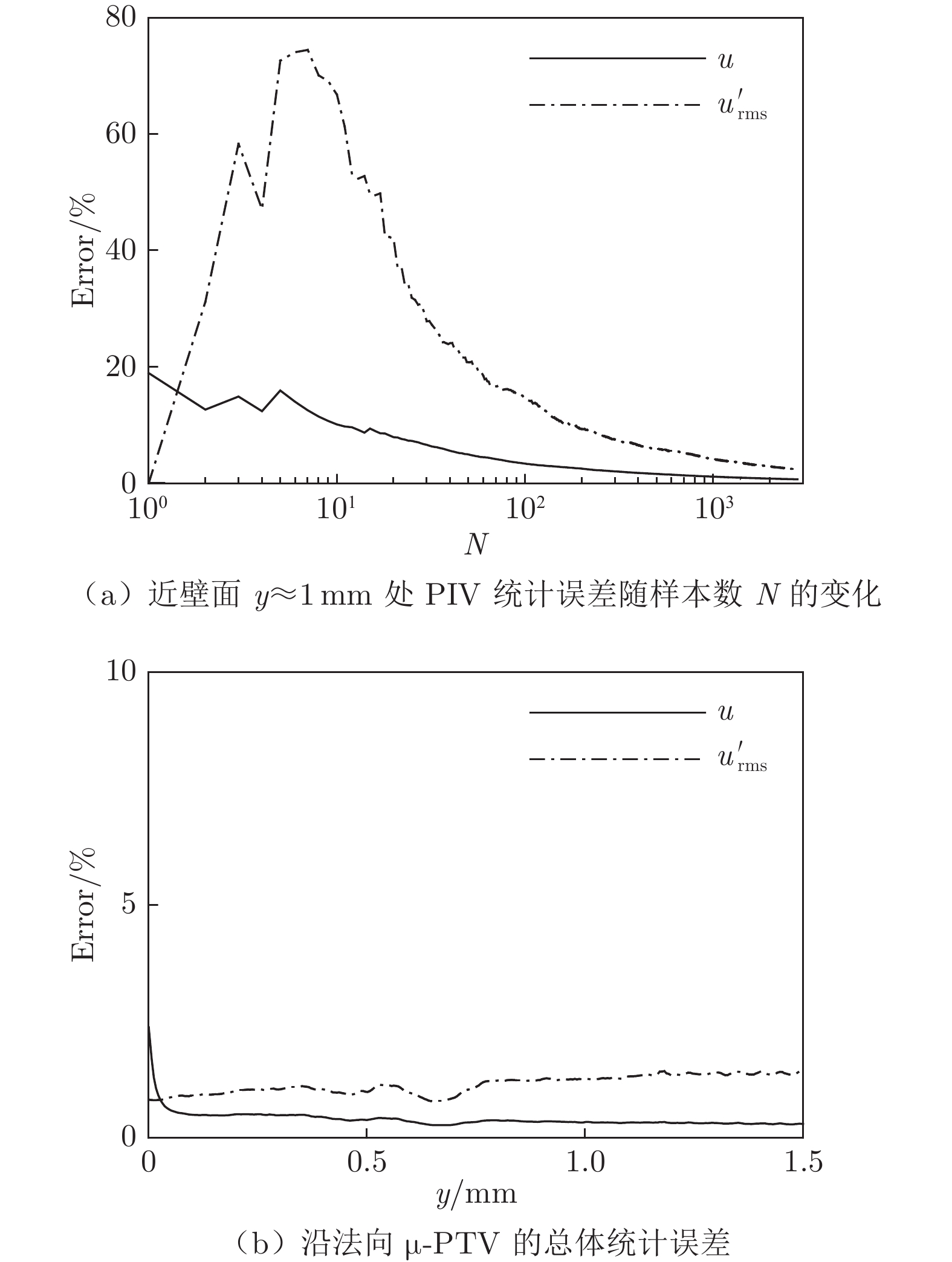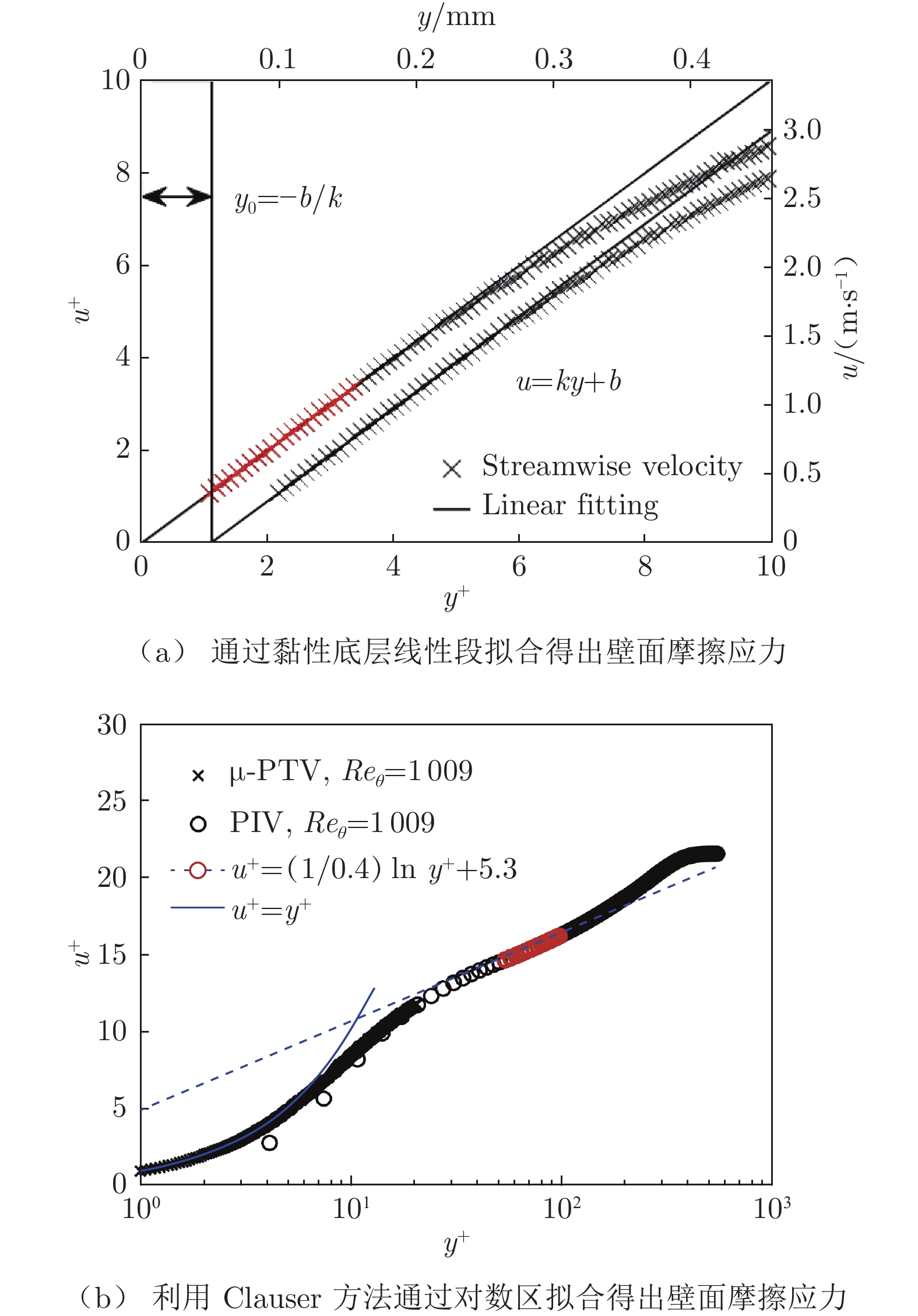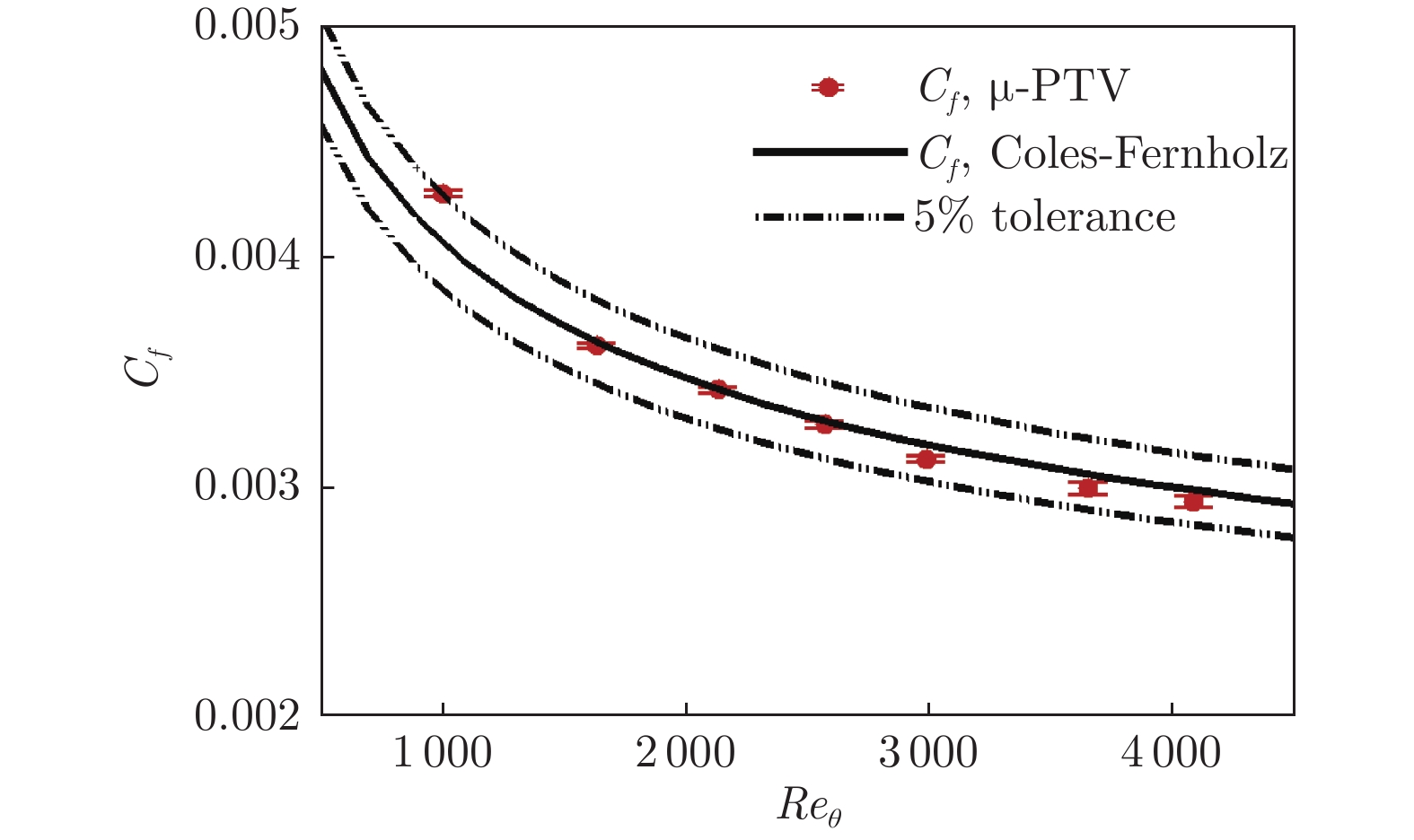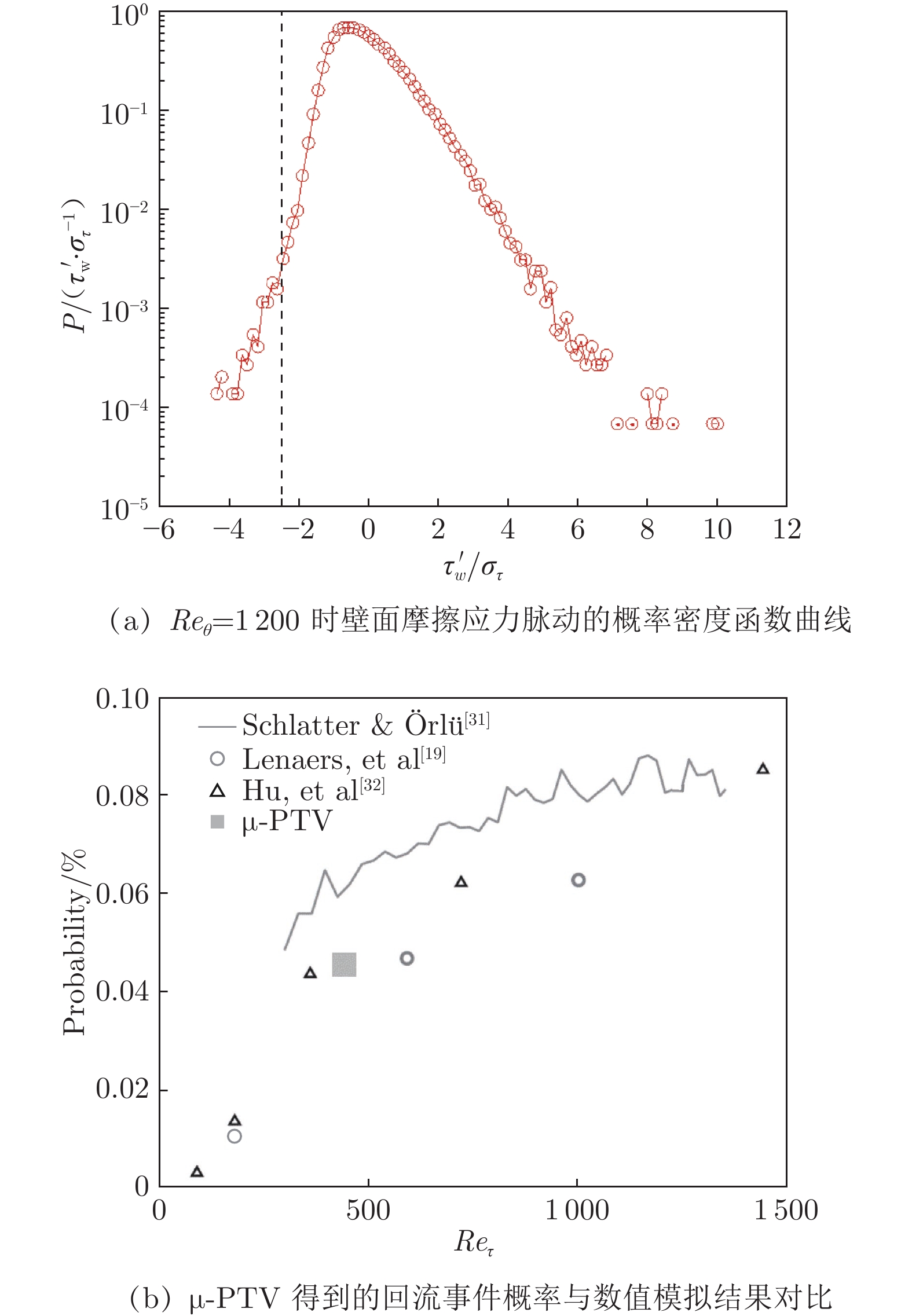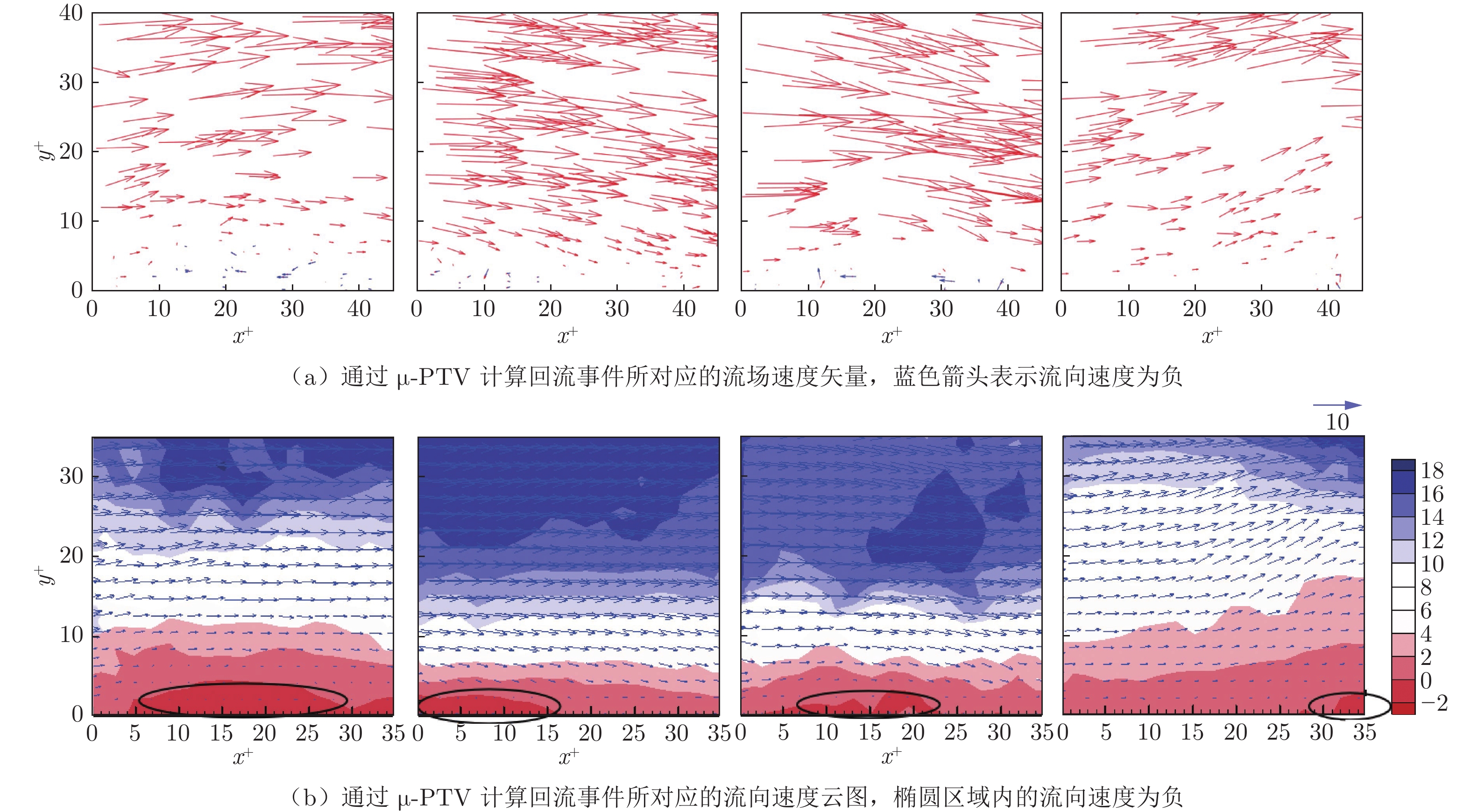Measurement of wall-shear stress via micro-particle tracking velocimetry
-
摘要: 采用微粒子追踪测速技术(Micro-Particle Tracking Velocimetry,µ-PTV)对近壁面的流场开展高空间分辨率测量,通过解析黏性底层的速度分布,应用一次线性回归计算得到壁面摩擦应力。测量了不同雷诺数(基于动量损失厚度 )下的湍流边界层壁面摩擦切应力,在Reθ =1200时获得了罕见回流事件的发生概率和流场结构。实验结果表明,采用µ-PTV技术可以实现壁面摩擦应力的准确测量,在Reθ =1634~4070时,摩擦阻力系数测量误差小于2%。回流事件的概率极低,在Reθ =1200时约为0.05%,尺度小于8×30个壁面单位,因此回流事件的测量对测量技术的空间分辨率要求较高;分析结果表明回流事件伴随壁面附近的强展向涡出现。Abstract: Micro-Particle Tracking Velocimetry (µ-PTV) was used to measure the flow field near the wall with high spatial resolution. By analyzing the velocity distribution of the viscous sublayer, the wall-shear stress can be analyzed by one-time linear regression. The wall-shear stress of the turbulent boundary layer at different Reynolds numbers based on momentum loss thickness was measured and the flow structure of reversal flow events was obtained at Reθ=1200. The results show that the micro-particle tracking velocimetry technology can accurately measure the wall-shear stress and the measurement error of wall-shear stress is below 2% for Reθ=1634–4070. Furthermore, the probability of reversal flow is extreme low, i.e., about 0.05% at Reθ=1200. The measured spatial scale of reversal flow structures is around 8×30 wall units, and therefore the measurement of reversal flow events requires high spatial resolution of the measurement technology. The results show that the reversal flow events occur with the appearance of strong spanwise vortices near the wall.es near the wall.
-
0 引言
目前,要求地面试验设备完全模拟高超声速飞行环境是非常困难的,在一个试验设备上进行所有环境的模拟试验更是不可能的。因此,需要研制多种试验设备,以满足高超声速试验需求[1-5]。
常规高超声速风洞主要模拟参数是马赫数和雷诺数[6],其他一些参数则主要通过高焓试验设备来模拟[7-8]。
在高超声速风洞运行中,气源不仅要维持风洞所必须达到的压力比,还需要满足雷诺数模拟的要求。一般来说,风洞的总压要足够高。如果风洞连续工作,高的压力比和高总压将使风洞消耗很大的动力,因而高超声速风洞多为暂冲式。
暂冲式常规高超声速风洞的运行方式是:气罐中的压缩空气经过加热系统达到所需温度,然后通过型面喷管,在试验段形成所需的高超声速流场,最后经由超声速扩散段升压后进入引射排气系统,排入大气,或经过冷却器进入真空系统,由真空泵系统排入大气。常规高超声速风洞一般加热温度在800K以下,主要是为了防止气流冷凝,不能真实模拟实际总温(马赫数6时达到1800K),因此,开展发动机及飞行器一体化带动力试验还需要满足总温要求的高焓设备。
燃烧加热风洞是目前高超声速飞行器地面模拟试验尤其是带动力试验的主要设备。在过去的十几年间,中国空气动力研究与发展中心研制了不同尺度的脉冲燃烧风洞,探索了一体化飞行器设计、计算与试验技术[7-9]。在此基础上,发展了基于脉冲燃烧风洞的大尺度飞行器带动力一体化试验技术[10-11],提出了一种基于一体化试验直接测力结果的飞行器和发动机性能评估方法。
由于采用燃烧加热方式,无论是采用氢燃料还是碳氢燃料,都会产生水蒸气(H2O)、二氧化碳(CO2)等燃烧产物,即形成所谓“污染”。污染组分将造成风洞试验气体物理化学属性与真实空气存在一定差异,导致地面试验难以完全模拟真实飞行状态下的所有来流参数,且给地面试验结果向真实飞行状态的外推带来不确定性。为了尽可能降低这种不确定性,地面试验一般需要慎重考虑试验来流与模拟对象环境之间的参数匹配问题:即通过有选择地调整污染来流的某些状态参数,使之逼近对应的真实飞行环境,同时放弃一些无法兼顾的非关键参数,以尽可能达到飞行器气动与推进性能的可靠模拟。
目前主要有两种模拟方式:对于气动力试验,一般采用静温、静压、马赫数模拟;对于发动机性能试验,也可以采用总焓、动压、马赫数模拟。
中国科技大学杨基明、罗喜胜等[12-13]通过典型升力体飞行器的试验和计算研究,证明污染组分使得斜激波波后参数相对纯净空气有一定变化,从而造成模型表面压力及模型的气动力有一定变化,但变化量较小。相对于纯净空气来流,污染空气来流时发动机推力、单位推力、比冲均有所下降。脉冲燃烧风洞采用氢氧燃烧加热,污染空气来流时推力性能下降相对较小,与纯净空气来流时较为接近。
西北工业大学宋文艳等[14]研究了H2O/CO2污染煤油燃料对超声速燃烧室的影响,认为污染对点火和超声速燃烧具有一定的抑制作用,污染组分的存在会导致燃烧室模态转换点发生变化。
谭宇等[15]在酒精燃烧和氢气燃烧两种加热方式的风洞设备上开展了匹配方案对超燃冲压发动机性能影响的试验研究,比较了两种目前较常用的气流参数匹配方案,结果表明:对于采用氢气燃烧加热方式的风洞设备,总焓动压马赫数(h0QM)匹配比静温静压马赫数(TPM)匹配能够获得更高的壁面静压和推力收益;对于采用酒精燃烧加热方式的风洞设备,两种匹配方案表现相当。
壁温比通常定义为模型壁面温度与恢复温度的比值。常规高超声速风洞来流温度较低,气流壁面恢复温度与壁面温度相差不大,接近于绝热状态;而燃烧加热脉冲风洞来流温度较高,风洞试验时间很短(300~600ms),壁面温度基本保持常温,接近于等温状态,气流壁面恢复温度与试验模型表面温差较大,气流对壁面的加热效应明显。壁面温度条件会影响到高超声速边界层内的流动参数,进而影响到流场的波系结构和气动性能。壁温降低引起摩擦系数的增加和边界层厚度减小,使得激波边界层作用区域变小;同时,冷壁使得边界层内亚声速部分声速较低,马赫数更高。
为了评估真实飞行条件下的飞行器气动性能,需重点考虑壁温对燃烧加热脉冲风洞试验结果的影响。
本文采用不通气标模,在常规高超声速风洞以及两个不同尺度(Φ2.4m和Φ600mm)的脉冲燃烧风洞中开展对比测力试验,结合数值计算,研究脉冲燃烧风洞水凝结、雷诺数及壁温比对模型气动性能的影响规律。
1 试验模型
试验模型采用不通气标模。对应Φ2.4m脉冲燃烧风洞,试验模型为大不通气标模,采用背部支撑,如图 1所示;对应常规高超声速风洞和Φ600mm脉冲燃烧风洞,试验模型为1/5缩比的小不通气标模,采用尾部支撑,如图 2所示。
2 脉冲燃烧风洞水凝结影响研究
为了获得水凝结对脉冲燃烧风洞试验数据的影响,采用小不通气标模,在Φ600mm脉冲燃烧风洞开展不同总温条件下的对比试验研究,分析测力结果。
2.1 对比试验参数
对Φ600mm脉冲燃烧风洞喷管进行了试验配套改造,在来流总温、组分不同的条件下,保持风洞出口马赫数一致。以现有的Ma6喷管为基础(总温1500K),设计制造总温为1200和1800K的喉道段,喷管出口马赫数与现有喷管一致。表 1为不通气高超标模试验参数(p0、T0分别为总压、总温,p、T分别为静压、静温)。
表 1 不同总温高超标模试验参数Table 1 Flow parameters of different T0 testsMa p0/MPa T0/K p/Pa T/K Re 6.0 4.5 1200 2368 162 7.08×106 6.0 5.1 1500 2398 210 4.98×106 6.0 5.8 1800 2374 263 3.61×106 2.2 试验结果
图 3、4给出了不通气高超标模的轴向力系数CA、法向力系数CN随迎角α变化的试验结果曲线。
试验表明:在总温1200~1800K试验状态下,最大轴向力系数差别为5.4%,说明水凝结对不通气高超标模的轴向力影响很小,约为5%左右。在-2°迎角时,总温1200K(有水凝结)试验状态的法向力系数较总温1500K减小了约40%;在0°~6°迎角下,法向力系数减小12%~5%,说明随着迎角的增加,模型下表面的凝结水蒸发,导致水凝结对法向力的影响减小。在-2°迎角时,总温1800K试验状态的法向力系数较总温1500K增加了约30%,说明总温1500K、-2°迎角状态在模型的下表面也发生了水凝结,导致模型下表面流场压力升高,法向力系数减小;而在其他迎角状态,总温1500K时并没有发生水凝结现象,因此法向力系数差别较小。
3 脉冲燃烧风洞雷诺数影响研究
3.1 对比试验参数
为了获得雷诺数对试验结果的影响,用不同尺度的不通气标模在Φ2.4m脉冲燃烧风洞和Φ600mm脉冲燃烧风洞进行对比试验,试验参数见表 2(CHIF:脉冲燃烧风洞)。
表 2 试验参数Table 2 Test parametersFacility Ma T0/K p0/MPa Φ2.4m CHIF 6 1575 4.76 Φ600mm CHIF 6 1500 4.61 3.2 试验和计算结果
图 5和6给出了大、小不通气标模在两个脉冲燃烧风洞的轴向力系数CA、法向力系数CN试验结果,同时也给出了两个模型按照对应风洞来流条件计算获得的气动力系数结果。
计算结果表明:模型尺度对不通气标模的轴向力有一定影响,小不通气标模的轴向力略大于大不通气标模,相差约2%~5%。由于两个脉冲燃烧风洞模拟条件基本相同,试验时间也接近,因此这个差异可以解释为模型尺度(雷诺数)造成的:小不通气标模的雷诺数小于大不通气标模,因此轴向力略大。试验并未能够反映出雷诺数的影响,这可能是由于两个模型支撑方式不同以及试验测量误差掩盖了差异。
两个模型的法向力结果不一致,主要是由于支撑方式不同造成的。前期研究表明,腹部支撑对轴向力影响不大,但对法向力影响显著。
计算与试验结果符合较好,使计算和试验得到了相互验证。
4 脉冲燃烧风洞壁温比影响研究
采用小不通气标模,通过Φ600mm脉冲燃烧风洞及常规高超声速风洞的试验对比,结合数值计算,研究壁温比对脉冲燃烧风洞试验结果的影响。
4.1 对比试验参数
Φ600mm脉冲燃烧风洞与Φ1m常规高超声速风洞的试验流场存在总温、雷诺数、壁温比等方面的差异。假设壁温300K,风洞流场参数对比如表 3所示(HWT:常规高超声速风洞;Tratio为壁温比)。
表 3 Φ1m常规高超声速风洞与Φ600mm脉冲燃烧风洞流场参数Table 3 Test parameters of Φ1m hypersonic wind tunnel and Φ600mm combustion heated impulse facilityFacility Ma p0/MPa T0/K γ Re Tratio Φ1m HWT 6.0 3.00 500 1.40 2.62×107 5.17 Φ600mm CHIF 6.0 4.65 1560 1.36 4.10×106 1.49 4.2 试验和计算结果
脉冲燃烧风洞试验与计算结果表明:采用等温壁300K条件计算获得的阻力系数与试验数据比较接近,误差在6%以内;绝热壁计算阻力系数较等温壁300K计算小5%(迎角6°)~15%(迎角-2°);不同壁温条件对升力系数的计算结果影响不大,与试验结果的误差分别在6%和8%以内;采用等温壁300K条件计算获得的结果与试验基本一致。图 7和8给出了脉冲燃烧风洞试验和计算的阻力系数CD及升力系数CL的对比曲线。
常规高超声速风洞试验和计算结果表明:不同壁温条件对计算结果影响不大,计算结果与试验符合较好,阻力误差在4%以内,升力误差在3%以内。图 9和10给出了相应的阻力系数和升力系数比较曲线。
通过试验验证,表明数值计算具有较高的可信度。为了进一步分析规律,采用数值计算分析了脉冲燃烧风洞与常规高超声速风洞阻力系数的数据相关性,如图 11所示。
(1) 脉冲燃烧风洞等温壁计算得到的阻力系数比常规高超声速风洞大7%(迎角6°)~17%(迎角-2°),迎角越小,差异越大。这个差异由多方面因素导致,主要有雷诺数、比热比、壁温比等。
(2) 针对同一个模型,分别采用脉冲燃烧风洞和常规高超声速风洞的模拟参数计算(壁面都取绝热壁条件),此时得到的结果差异应该排除了壁温比的影响,而反映了两个风洞模拟条件(如雷诺数、比热比)不同引起的变化量,计算获得的这一部分的影响量约为3%(迎角6°)~6%(迎角-2°)。
(3) 除去两个风洞模拟条件(如雷诺数、比热比)不同引起的阻力变化量,可得到壁温比的影响量约为4%(迎角6°)~12%(迎角-2°),迎角越小,差异越大。
5 结论
通过脉冲燃烧风洞与常规高超声速风洞不通气高超标模对比试验和计算,得到如下结论:
(1) 脉冲燃烧风洞获得的气动力系数变化规律与常规高超声速风洞一致;
(2) 雷诺数、壁温比对阻力系数均有影响,其中壁温比影响显著,脉冲燃烧风洞获得的阻力系数明显大于常规高超声速风洞;
(3) 水凝结对不通气高超标模的轴向力影响较小,对法向力影响较大,且不同迎角状态影响量不同。
-
表 1 零压力梯度湍流边界层流动参数
Table 1 Parameters of the zero-pressure gradient turbulent boundary layers
x Reθ U∞/(m·s–1) θ/mm uτlinear/(m·s–1) uτClauser/(m·s–1) ν· uτ–1/µm δ0.99/mm H12 863 1200 8.00 2.310 0.351 0.333 43.7 19.83 1.412 1400 1009 3.96 3.965 0.183 0.179 84.0 32.37 1.473 1400 1634 5.96 4.355 0.251 0.248 61.1 34.59 1.449 1400 2130 7.93 4.126 0.326 0.320 47.1 32.92 1.435 1400 2565 9.79 4.075 0.395 0.385 38.9 32.05 1.426 1400 2978 11.78 3.920 0.460 0.453 33.4 31.30 1.419 1400 3638 15.70 3.573 0.601 0.607 25.5 28.84 1.402 1400 4070 18.65 3.389 0.709 0.690 21.7 27.53 1.396 -
[1] 许春晓. 壁湍流相干结构和减阻控制机理[J]. 力学进展,2015,45(1):111-140. XU C X. Coherent structures and drag-reduction mechanism in wall turbulence[J]. Advances in Mechanics,2015,45(1):111-140.
[2] BAARS W J,SQUIRE D T,TALLURU K M,et al. Wall-drag measurements of smooth- and rough-wall turbulent boundary layers using a floating element[J]. Experiments in Fluids,2016,57(5):1-16. doi: 10.1007/s00348-016-2168-y
[3] CHENG X Q,WONG C W,ZHOU Y. A floating-element force balance of high resolution for friction drag measure-ment[J]. Measurement Science and Technology,2020,32(3):035301. doi: 10.1088/1361-6501/abb33d
[4] DRIVER D M. Application of oil-film interferometry skin-friction measurement to large wind tunnels[J]. Experiments in Fluids,2003,34(6):717-725. doi: 10.1007/s00348-003-0613-1
[5] IRELAND P T,JONES T V. Liquid crystal measurements of heat transfer and surface shear stress[J]. Measurement Science and Technology,2000,11(7):969-986. doi: 10.1088/0957-0233/11/7/313
[6] BAI H L,LI W J,CHOW W,et al. A carbon nanotube sensor for wall shear stress measurement[J]. Experiments in Fluids,2010,48(4):679-691. doi: 10.1007/s00348-009-0760-0
[7] LIU X H,LI Z Y,WU C J,et al. Toward calibration-free wall shear stress measurement using a dual hot-film sensor and Kelvin bridges[J]. Measurement Science and Technology,2018,29(10):105303. doi: 10.1088/1361-6501/aadb1b
[8] HEAD M R,RECHENBERG I. The Preston tube as a means of measuring skin friction[J]. Journal of Fluid Mechanics,1962,14(1):1-17. doi: 10.1017/s0022112062001020
[9] DURST F,KIKURA H,LEKAKIS I,et al. Wall shear stress determination from near-wall mean velocity data in turbu-lent pipe and channel flows[J]. Experiments in Fluids,1996,20(6):417-428. doi: 10.1007/BF00189380
[10] HUTCHINS N,CHOI K S. Accurate measurements of local skin friction coefficient using hot-wire anemometry[J]. Progress in Aerospace Sciences,2002,38(4-5):421-446. doi: 10.1016/S0376-0421(02)00027-1
[11] LI W F,ROGGENKAMP D,JESSEN W,et al. Reynolds number effects on the fluctuating velocity distribution in wall-bounded shear layers[J]. Measurement Science and Technology,2017,28(1):015302. doi: 10.1088/1361-6501/aa4e9e
[12] RODRÍGUEZ-LÓPEZ E,BRUCE P J K,BUXTON O R H. A robust post-processing method to determine skin friction in turbulent boundary layers from the velocity profile[J]. Experiments in Fluids,2015,56(4):1-16. doi: 10.1007/s00348-015-1935-5
[13] GATTI D,GÜTTLER A,FROHNAPFEL B,et al. Experimental assessment of spanwise-oscillating dielectric electroactive surfaces for turbulent drag reduction in an air channel flow[J]. Experiments in Fluids,2015,56(5):1-15. doi: 10.1007/s00348-015-1983-x
[14] KÄHLER C J,SCHOLZ U,ORTMANNS J. Wall-shear-stress and near-wall turbulence measurements up to single pixel resolution by means of long-distance micro-PIV[J]. Experiments in Fluids,2006,41(2):327-341. doi: 10.1007/s00348-006-0167-0
[15] 申俊琦,王建杰,潘翀. 平板湍流边界层瞬时摩擦阻力的光学测量和统计分析[J]. 气体物理,2020,5(5):13-23. SHEN J Q,WANG J J,PAN C. Optical measurement and statistical analysis of instantaneous wall-shear stress in a turbulent boundary layer[J]. Physics of Gases,2020,5(5):13-23.
[16] SPALART P R,COLEMAN G N. Numerical study of a separation bubble with heat transfer[J]. European Journal of Mechanics-B/Fluids,1997,16(2):169-189.
[17] KHOURY G K E,SCHLATTER P,BRETHOUWER G,et al. Turbulent pipe flow: Statistics, re-dependence, structures and similarities with channel and boundary layer flows[J]. Journal of Physics:Conference Series,2014,506:012010. doi: 10.1088/1742-6596/506/1/012010
[18] CARDESA J I,MONTY J P,SORIA J,et al. Skin-friction critical points in wall-bounded flows[J]. Journal of Physics:Conference Series,2014,506:012009. doi: 10.1088/1742-6596/506/1/012009
[19] LENAERS P,LI Q,BRETHOUWER G,et al. Rare backflow and extreme wall-normal velocity fluctuations in near-wall turbulence[J]. Physics of Fluids,2012,24(3):035110. doi: 10.1063/1.3696304
[20] CHIN R C,MONTY J P,CHONG M S,et al. Conditionally averaged flow topology about a critical point pair in the skin friction field of pipe flows using direct numerical simula-tions[J]. Physical Review Fluids,2018,3(11):114607. doi: 10.1103/physrevfluids.3.114607
[21] GUERRERO B,LAMBERT M F,CHIN R C. Extreme wall shear stress events in turbulent pipe flows: spatial charac-teristics of coherent motions[J]. Journal of Fluid Mechanics,2020,904:A18. doi: 10.1017/jfm.2020.689
[22] GUERRERO B,LAMBERT M F,CHIN R C. Precursors of backflow events and their relationship with the near-wall self-sustaining process[J]. Journal of Fluid Mechanics,2022,933:A33. doi: 10.1017/jfm.2021.1082
[23] ECKELMANN H. The structure of the viscous sublayer and the adjacent wall region in a turbulent channel flow[J]. Journal of Fluid Mechanics,1974,65(3):439-459. doi: 10.1017/s0022112074001479
[24] COLELLA K J,KEITH W L. Measurements and scaling of wall shear stress fluctuations[J]. Experiments in Fluids,2003,34(2):253-260. doi: 10.1007/s00348-002-0552-2
[25] TROPEA C, YARIN A L, FOSS J F. Springer handbook of experimental fluid mechanics[M]. Berlin: Springer, 2007.
[26] SORIA J. An investigation of the near wake of a circular cylinder using a video-based digital cross-correlation particle image velocimetry technique[J]. Experimental Thermal and Fluid Science,1996,12(2):221-233. doi: 10.1016/0894-1777(95)00086-0
[27] WESTERWEEL J,SCARANO F. Universal outlier detec-tion for PIV data[J]. Experiments in Fluids,2005,39(6):1096-1100. doi: 10.1007/s00348-005-0016-6
[28] CROCKER J C,GRIER D G. Methods of digital video microscopy for colloidal studies[J]. Journal of Colloid and Interface Science,1996,179(1):298-310. doi: 10.1006/jcis.1996.0217
[29] BENEDICT L H,GOULD R D. Towards better uncertainty estimates for turbulence statistics[J]. Experiments in Fluids,1996,22(2):129-136. doi: 10.1007/s003480050030
[30] NAGIB H M,CHAUHAN K A,MONKEWITZ P A. Approach to an asymptotic state for zero pressure gradient turbulent boundary layers[J]. Philosophical Transactions of the Royal Society A:Mathematical, Physical and Enginee-ring Sciences,2007,365(1852):755-770. doi: 10.1098/rsta.2006.1948
[31] SCHLATTER P,ÖRLÜ R. Assessment of direct numerical simulation data of turbulent boundary layers[J]. Journal of Fluid Mechanics,2010,659:116-126. doi: 10.1017/s0022112010003113
[32] HU Z W,MORFEY C L,SANDHAM N D. Wall pressure and shear stress spectra from direct simulations of channel flow[J]. AIAA Journal,2006,44(7):1541-1549. doi: 10.2514/1.17638







 下载:
下载:











